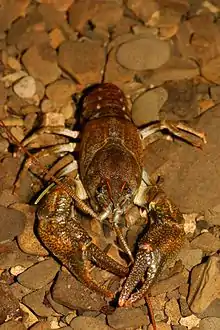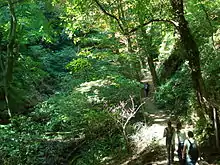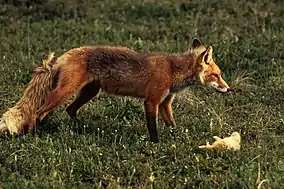Austropotamobius torrentium
Austropotamobius torrentium, also called the stone crayfish, is a European species of freshwater crayfish in the family Astacidae. It is mostly found in tributaries of the Danube, having originated in the northern part of the Balkan Peninsula.
| Austropotamobius torrentium | |
|---|---|
 | |
| Scientific classification | |
| Domain: | Eukaryota |
| Kingdom: | Animalia |
| Phylum: | Arthropoda |
| Class: | Malacostraca |
| Order: | Decapoda |
| Suborder: | Pleocyemata |
| Family: | Astacidae |
| Genus: | Austropotamobius |
| Species: | A. torrentium |
| Binomial name | |
| Austropotamobius torrentium (Schrank, 1803) | |
| Subspecies[2] | |
| |
| Synonyms[3] | |
| |
Description
A. torrentium grows to a length of around 10 centimetres (4 in), and has a smooth brown carapace, with an untoothed triangular rostrum; the underside is creamy white. Males have larger claws than females, but females have a noticeably larger abdomen.[4] As in other crayfish, the first two pairs of pleopods are specialised for sperm transfer in males, while the female's pleopods are uniform, and used for brooding eggs.[4]
Distribution

The distribution of A. torrentium is centred on the Danube system, extending from the Olt River in Romania upstream to Germany and Switzerland and into parts of the Rhine and Elbe basins. It is widespread in southern Germany, Switzerland, Austria, Hungary, Slovenia, Croatia and Serbia.[5] Contrary to some previous records, A. torrentium does not appear to occur in Luxembourg, Poland or Ukraine.[6]
In France, at the western edge of the species' range, two populations remain, one in Alsace and one in Lorraine.[6] The Czech Republic and Slovakia are at the north-eastern periphery of the natural range of A. torrentium, with only four and six known populations, respectively, all those in Slovakia being in the Male Karpaty hills (Lesser Carpathians).[7] The northernmost point inhabited by A. torrentium is near the city of Dresden in the German federal state of Saxony.[8]
Italy is at the south-western margin of the distribution of A. torrentium, with at least two populations in the Slizza drainage (a tributary of the Danube) near Tarvisio.[6] To the south-east, the species has entered the Drin River in Albania, and was discovered in 2005 in the European part of Turkey.[9] In Romania, it is present in the Apuseni Mountains and in the Carpathian foothills to the southwest, overlapping slightly with the distribution of the noble crayfish Astacus astacus.[4]
The populations in the west of the species' range are genetically depauperate, while populations from the upper Kupa basin are as genetically distinct from the rest of A. torrentium as some species in related genera are from each other, suggesting A. torrentium originated in the Western Balkans.[10]
Ecology

The preferred habitat of A. torrentium is cold, fast-flowing streams, although some live in larger rivers and lakes. It digs burrows in the banks and hides under submerged roots or rocks, emerging at night to feed.[4]
Adult A. torrentium consume a variety of plant materials, including fallen leaves, while the juveniles chiefly feed on aquatic invertebrates.[4] Natural predators of fully grown A. torrentium include foxes, bears, wolves, otters and badgers, while the young animals are targeted by fish.[4] The species is sensitive to low levels of dissolved oxygen, and to chemical pollution.[4]
Beside naturally occurring threats, A. torrentium has also suffered from the introduction of the crayfish plague, Asphanomyces astaci, carried by invasive crayfish species from North America, and from the release of detergents into streams while washing laundry.[4]
Life cycle
Mating takes place at the end of October. The female then carries the 40–70 fertilised eggs on her pleopods until the eggs are ready to hatch. Juveniles moult up to 4 or 5 times per year, but as they mature, this slows to once or twice a year, usually in May, June or July. Sexual maturity is reached after 3 to 5 years, by which time the animal has grown to a length of 35–50 millimetres (1.4–2.0 in). Adult males can reproduce every year, but females do not reproduce for at least one year after producing eggs.[4]
Conservation status
A. torrentium is one of the most threatened species in Europe:[8] as well as protection under various national laws, it is designated data deficient on the IUCN Red List,[1] it is listed in Appendix III of the Bern Convention,[11] and it is protected under the EU Habitats Directive.[12]
References
- L. Füreder; F. Gherardi & C. Souty-Grosset (2010). "Austropotamobius torrentium". IUCN Red List of Threatened Species. 2010: e.T2431A121724677. Retrieved 6 January 2018.
- Crandall, Keith A; De Grave, Sammy (2017). "An updated classification of the freshwater crayfishes (Decapoda: Astacidea) of the world, with a complete species list". Journal of Crustacean Biology. 37 (5): 615–653. doi:10.1093/jcbiol/rux070.
- James W. Fetzner Jr. (January 14, 2008). "Austropotamobius torrentium (Schrank, 1803)". Crayfish Taxon Browser. Carnegie Museum of Natural History. Archived from the original on 2011-06-11. Retrieved 2010-02-11.
- Lucian Pârvulescu. "Austropotamobius torrentium (Schrank 1803)". Crayfish of Romania. Retrieved February 10, 2010.
- Lucian Pârvulescu. "Distribution". Crayfish of Romania. Archived from the original on 28 January 2010. Retrieved February 10, 2010.
- Y. Machino & L. Füreder (2005). "How to find a stone crayfish Austropotamobius torrentium (Schrank, 1803): a biogeographic study in Europe" (PDF). Bulletin Français de la Pêche et de la Pisciculture. 376–377 (376–377): 507–517. doi:10.1051/kmae:2005010. Archived from the original (PDF) on 2011-07-18.
- E. Stloukal & M. Harváneková (2005). "Distribution of Austropotamobius torrentium (Decapoda: Astacidae) in Slovakia" (PDF). Bulletin Français de la Pêche et de la Pisciculture. 376–377 (376–377): 547–552. doi:10.1051/kmae:2005014. Archived from the original (PDF) on 2011-07-18.
- Peer Martin; Matthias Pfeifer & Gert Füllner (2008). "First record of the stone crayfish Austropotamobius torrentium (Schrank, 1803) (Crustacea: Decapoda: Astacidae) from Saxony (Germany)" (PDF). Faunistische Abhandlungen. 26: 103–108.
- Muzaffer Mustafa Harlioğlu & Utku Güner (2007). "A new record of recently discovered crayfish, Austropotamobius torrentium (Shrank, 1803), in Turkey" (PDF). Bulletin Français de la Pêche et de la Pisciculture. 387 (387): 1–5. doi:10.1051/kmae:2007013. Archived from the original (PDF) on 2011-07-17.
- Peter Trontelj; Yoichi Machino & Boris Sket (2005). "Phylogenetic and phylogeographic relationships in the crayfish genus Austropotamobius inferred from mitochondrial COI gene sequences". Molecular Phylogenetics and Evolution. 34 (1): 212–226. doi:10.1016/j.ympev.2004.09.010. PMID 15579394.
- "Appendix III. Protected fauna species". Convention on the Conservation of European Wildlife and Natural Habitats. Council of Europe. November 19, 1979.
- "Council Directive 92/43/EEC of 21 May 1992 on the conservation of natural habitats and of wild fauna and flora". European Union.
